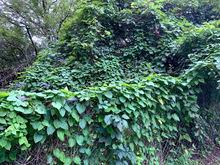Quick facts
Rough potato (Metaplexis japonica) is a non-native plant that was found in 2020 in Stearns County, Minnesota.
- Rough potato is an herbaceous perennial vining milkweed originating from eastern Asia.
- There are no vining milkweeds native to Minnesota.
- Rough potato climbs aggressively and can easily overtake vegetation.
- Please report this species so we can better understand its distribution in the wild. Report to Minnesota Department of Agriculture Report a Pest.
Before being discovered in Minnesota, rough potato was only recorded once in the United States in the 1950s spreading through a crop field in Ames, Iowa. In 2020, a master naturalist reported a vining milkweed, later identified as rough potato, that appeared to be overtaking parts of the Lake Wobegon trail near Holdingford, Minnesota.
How to identify rough potato
- Rough potato is a perennial, herbaceous, milkweed vine with white to pink flowers.
- Stems: Herbaceous vines that twine adjacent structures. Vine can grow up to 25 feet long and above ground parts die back each winter.
- Leaves: Opposite, heart shaped leaves, 2-5 inches long
- Flowers: Five long and curled petals, white to light pink in color with visible hairs.
- Fruit: Large, oblong, spiked pod clusters similar to common milkweed. When mature, the pods open to release rounded and flattened brown seeds with silky filament.
- Roots: Rough potato has a vigorous underground rhizome system.
Common look-alikes
Common milkweed (Asclepias syriaca) is a native, perennial herbaceous plant in the milkweed family. It commonly grows in sunny areas and ditches and is a primary part of the monarch butterfly’s diet. Leaves are oval and opposite and plants can grow up to 5 feet tall. Flowers develop at the top of the stem in an umble pattern and are typically light pink. Seed pods mature late in the fall.
Black swallow-wort (Cynanchum louiseae) is an herbaceous perennial vine on Minnesota’s Prohibited - Eradicate noxious weed list. Vines can grow 6 feet long and in a variety of habitats including full sun, and full shade. Flowers have 5 dark purple petals and are 1/8 inch with a yellow center. Seed pods are smooth and slender, 2.5 inches long.
Pale swallow-wort (Cynanchum rossicum) is a herbaceous, perennial vine that twines. It has slender, simple, opposite leaves and milkweed-like seed pods.
Honey-vine climbing milkweed (Cynanchum laeve) is an herbaceous perennial vine that is native in Iowa and has been moving north. Please report it if found in Minnesota. The leaves look very similar to rough potato (heart shaped and opposite), but the seed pods are smooth and larger than swallow-worts, and flowers are similar to rough potato but white and hairless.
Reporting and controlling rough potato
Please report rough potato. As with all non-native species found in unmanaged areas, report findings of this species using one of the following methods:
- Use the Great Lakes Early Detection Network (GLEDN) free mobile app (preferred). Species listed as dog-strangling vine, Vincetoxicum rossicum in the app.
- Report using the EDDMapS Midwest web-based mapping system for documenting invasive species. Species listed as dog-strangling vine, Vincetoxicum rossicum on the website.
- Report to Minnesota Department of Agriculture Report a Pest.
Management
Management in rough potato is not well studied. It is thought that methods that work for pale swallow-wort will work for rough potato.
- Cultivation: Not likely to persist in crops that are cultivated annually.
- Mechanical control: Can break when hand-pulled. Roots can be dug out and disposed of, but continual monitoring is necessary. Mowing is not recommended as it is likely to spread seeds.
- Herbicide control: Spot spray leaves with glyphosate, triclopyr, or imazapyr while the plant is flowering. For smaller populations, herbicide can be applied directly to a cut stem. Follow herbicide application directions on the label.
Reviewed in 2021


